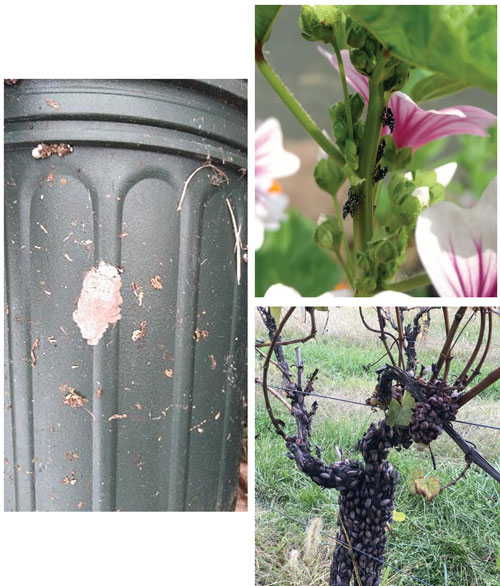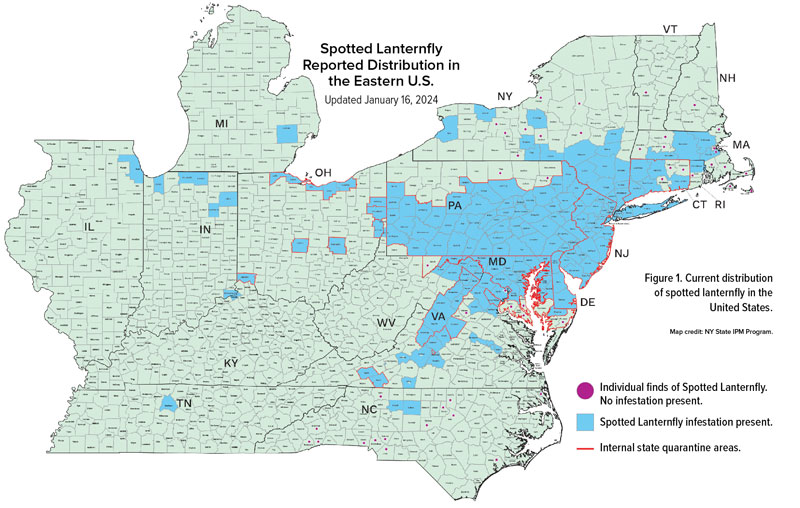3/1/2024
Getting Ready for Spotted Lanternfly in 2024
JC Chong
You cannot miss the alarming newspaper headlines and the TikTok and YouTube videos of folks stomping on spotted lanternflies (SLF) in 2023 unless you were hiding under a rock and completely cut off from all forms of communication. Since you’re reading this article, I’m assuming that you aren’t the hermits I just described.
Since its first detection in Berks County, Pennsylvania, in 2014, SLF has spread to 17 states, most recently Illinois, Kentucky and Tennessee (Figure 1). Quarantines have been imposed on movement of goods and equipment, including horticultural products, from several counties in seven states.
Where will SLF go next?
Potentially far and wide, but there are some places they may not be able to establish, said a study published in September 2023. A research team from Pennsylvania State University concluded in the study that areas with fewer than 991 accumulated degree day (ADD; start date of January 1 and the lower threshold temperature of 50.7F/10.4C) are unlikely to provide enough time for SLF to complete development and reproduction. This finding suggests that the distribution of SLF in the eastern United States will be limited by latitude and altitude, and the invasive pest likely will not be able to establish in the mountain tops of the Southern Appalachian Mountains, and much of the Northern Appalachian Mountains and Allegheny Plateau.
Being a resident of South Carolina, I’m reading the report’s major finding as, “Since much of the Carolinas can accumulate at least 2,500 degree-days per year, your backyard is fair game for SLF to invade and establish.” I’m ill-prepared in the tasks of swatting or stomping on the inch-long, colorful planthoppers. I certainly don’t look forward to the associated public and media hysteria, and the quarantines or regulatory restrictions.
I decided to check in with Brian Walsh, an extension educator at Penn State and my trusted source for all things SLF, hoping that he had some words of wisdom that could brighten my prospects. Brian has had the unique misfortune of being in the front row seat to the SLF drama ever since the first ever infestation was reported in Berks County where he’s based. Brian’s experience will be able to tell me what to expect and what to do about SLF invasions in 2024.
I asked Brian for his outlook for SLF in 2024.
“I think SLF will continue to expand its range geographically and new finds will be made in highly disparate locations where it has hitchhiked to on human conveyances,” said Brian.
While the new study demonstrated that the distribution of SLF will be limited by the colder climate on the mountain tops and at higher latitudes, we don’t know much about how warmer temperatures might limit their spread. What we do know is that a single egg mass (containing, on average, 35 eggs) glued to the side of a rail car, tractor-trailer, tree or pot (Figure 2) can start a new population somewhere far away from its original home.
Microclimates and year-to-year variations in temperature in a certain area will be important in deciding whether an SLF population can successfully establish. For example, a population may be able to persist in a warmer river valley in a theoretically unsuitable latitude. Or a population that could establish in a marginally suitable area during normal or warm years may fail after suffering one year when the temperature drops below the minimum needed for successful development and reproduction.
I wondered if the risk of SLF establishment will be minimal in some parts of this country where tree-of-heaven (Ailanthus altissima), which SLF requires for growth, is sparsely distributed. With a heavy sigh, Brian corrected me that tree-of-heaven is a preferred host, but it isn’t an essential or required host. A study has conclusively demonstrated that, while SLF reaches adulthood faster and survives better when they have access to tree-of-heaven, they can also complete development and lay viable eggs when feeding on weeping willow, birch, black walnut and silver maple in the absence of tree-of-heaven.
We don’t know the full host range of SLF. So far, only two plant groups are highly preferred and known to be killed by SLF—tree-of-heaven and (wild and cultivated) grapes. SLF is highly polyphagous. They’ll take a drink from any plant species with phloem (with the exclusion of most or all conifers).
Brian also observed second- and third-instar SLF enjoying the types of crape myrtles that are available in Pennsylvania. So who’s to say an SLF won’t switch hosts and be able to sustain a viable population feeding on other host plant species—such as muscadines, red maples and crape myrtles—when they invade the South? Although SLF don’t feed on conifers, they’re happy to deposit eggs masses on individual conifers or Christmas trees. This can complicate monitoring, inspection and quarantine.
 It's likely that climate, host plants and natural enemies will influence the distribution and population size of SLF from year to year. While the reasons aren’t entirely clear, Brian observed that SLF populations often build up in the newly established area for several years (approximately four to five years) then crash. But that doesn’t mean the population goes away completely. Folks in several Pennsylvanian counties where infestations were first reported are now reporting seeing only a handful of SLF in the last few years. This observation brings me hope that SLF is still following the same principle of many insect species—what goes up must come down.
It's likely that climate, host plants and natural enemies will influence the distribution and population size of SLF from year to year. While the reasons aren’t entirely clear, Brian observed that SLF populations often build up in the newly established area for several years (approximately four to five years) then crash. But that doesn’t mean the population goes away completely. Folks in several Pennsylvanian counties where infestations were first reported are now reporting seeing only a handful of SLF in the last few years. This observation brings me hope that SLF is still following the same principle of many insect species—what goes up must come down.
Figure 2. An egg mass on a plant pot. Photo: Brian Walsh, Penn State Extension. • Figure 3. Young nymphs on a hollyhock. Photo: Brian Walsh, Penn State Extension. • Adult SLF on a grape vine. Photo: Holly Shugart.
The hope of an eventually “mellowing” SLF infestation doesn’t negate the necessity of preparing for an SLF invasion for two reasons. First, SLF is polyphagous and can feed on many important landscape ornamental plant species. Left untreated, high numbers of nymphs can bleed individual perennial stems to death. And both nymphs and adults produce copious amounts of honeydew and sooty mold growth that can make a serious mess, staining plant material, pavers, decks and just about anything else it grows on. Removing those stains can be difficult, if not impossible. Clients and consumers of ornamental plants will likely demand actions to mitigate the impacts of infestation.
Secondly, and perhaps more importantly, being a regulated pest, the detection of SLF will trigger regulatory or quarantine actions. Quarantine has the potential to severely disrupt interstate and international shipment of horticultural goods. The quarantines and their enforcement vary from state to state, so it’s important to understand your local requirements. To comply with quarantine orders, inspection efforts often must be increased during peak plant material shipping times in the fall, which are also peak SLF flight periods.
Brian has seen swarms of new SLF land in the freshly inspected materials or the backs of trucks as they’re being loaded. Growers must adjust when and where they load material (out from under trees, loading in the morning when SLF are less likely to be flying), as well as to increase insecticide sprays on material that’s being shipped. Some have increased inspections and even resorted to using exclusion netting on picked orders once they’ve been inspected. These extra efforts cost money and time.
“What are the most impacted ornamental tree species?” I asked. Brian reported that red and silver maples are hit consistently by adults in the fall. River birch and willow are also consistent hosts for older nymphs and adults in the summer, according to information from Penn State. Nymphs prefer roses and most perennials (in addition to tree-of-heaven and grapes) earlier in the season. Brian has also seen SLF flocking to styrax or Japanese snowball.
As for damage to plants grown in nurseries, “luckily, we’ve seen surprisingly little,” Brian reported. Infestations are associated with large amounts of honeydew and sooty mold, which can be unpleasing aesthetically. Large populations can reduce the vigor of smaller plants. Feeding and injection of digestive enzymes (via saliva) may also cause necrotic damage under the bark of some maple varieties. Again, the bigger issue may be the regulatory actions triggered by the detection of eggs or any life stage of SLF on plants shipped from nurseries and Christmas tree farms.
How do you manage SLF?
“I think the most important thing that a professional can do is to identify potential hosts on a property and have a plan in place for if/when SLF shows up,” Brian advised.
It’ll help to prepare by predicting for egg hatch using the Penn State Spotted Lanternfly Percent Hatch Map (tools.cei.psu.edu/slf), which displays the probability of egg hatch in any area based on current temperature. Again, microclimate in an area can fast-track or delay egg hatch. Therefore, egg hatch must still be confirmed by looking or trapping (using sticky bands) for nymphs (bright black with white dots; Figure 3).
It’s important to understand that it’s impossible to prevent SLF from coming onto a property.
“In some situations, there isn’t much reason to treat [if] they are just moving through,” said Brian.
Similarly, there isn’t empirical evidence that removing host trees, such as tree-of-heaven, will prevent SLF from entering a property or lessen SLF impact, particularly if those hosts remain on a neighboring property. Remember that only tree-of-heaven and grapes have been killed by multiple years of heavy SLF infestations; other plant species may not require the same level of management as these two preferred species.
There isn’t a one-size-fits-all management approach. A number of factors—such as SLF population size and life stage, vulnerability of plants (due to age or species), residential vs. commercial property, quarantine compliance, management options available or preferred, etc.—will determine the final management program.
For example, SLF are attracted to certain trees during certain times. Treatment of these “hot” trees with insecticides—such as drenching, bark banding or trunk injecting with dinotefuran—may have an outsize impact on the SLF population on the property. The same approach may not be legal, be too expensive or have too high of an environmental risk for an area-wide management program for all the trees in the same area to be treated with dinotefuran.
Many insecticides are effective against SLF. Brian referred to the Penn State SLF Management Guide, which includes lists of insecticides, their relative effectiveness, when to use, and the pros and cons of using each group of the insecticides. Researchers continue to identify potential biological control agents and refine cultural management approaches.
As parting words, Brian encouraged everyone to, “take time to get educated, find out your state’s quarantine rules or laws, and make good decisions. We cannot spray our way out of our SLF troubles, but targeted sprays or treatments can be very effective locally and help business owners minimize the impacts. If you are providing services, educate the property manager and make sure they have reasonable expectations. This is not like treating dandelions in a lawn and taking care of the problem for the season.”
This is excellent advice to go by as we prepare for the next “SLF season” in 2024. GT
JC Chong is Technical Development Manager at SePRO and Adjunct Professor at Clemson University.
